National Geographic Magazine seems to be keen on slime mould (or ‘slime mold’ as it prefers to call it). The magazine has featured slime mould articles in several issues over the years.
I had no knowledge of slime mould myself until I received a phone call from Brian Brock, inviting me to photograph some ‘fungus’ at his home.
I called in to Brian’s home at the end of a very wet day. Brian pointed the fungus out to me in his front garden. He said that the rain had possibly washed some of it away. I found close-up photography difficult, but here below is one reasonable shot of mine: –
I managed to take a few shots of some different patches of ‘fungus’ before going inside. Brian then proceeded to show me several slime mould references in some of his library of books. He then showed me some samples of slime mould, which he had collected, under his microscope.
(According to Wikipedia , “Slime mold or slime mould is a broad term describing some organisms that use spores to reproduce. Slime molds were formerly classified as fungi but are no longer considered part of this kingdom. Although not related to one another, they are still sometimes grouped for convenience within the paraphyletic group referred to as kingdom Protista.” According to the Bing Dictionary, “slime mold (is an) organism that secretes slime: a simple organism that forms a small slimy amoeboid mass, e.g. on fallen logs, and produces spore-bearing reproductive organs similar to those of a fungus.”)
It was all fascinating stuff for someone like me with no prior experience in such matters. When the time came for me to leave, Brian gave me two National Geographic Magazine references on the topic. One was from 1926 and the other was from 1981.
One of the references shown to me by Brian included the name of a William Crowder. His name came up again when I found the April 1926 issue of National Geographic Magazine at http://ngm-beta.nationalgeographic.com/archive/marvels-of-mycetozoa-exploration-of-a-long-island-swamp-reveals-some-of-the-secrets-of-the-slime-m/. That issue included an article written by William Crowder titled “Marvels of Mycetozoa : Exploration of a Long Island Swamp Reveals Some of the Secrets of the Slime Molds , Dwelling on the Borderland Between the Plant and Animal Kingdoms”.
The article was introduced as “Observing slime molds in the wild , the author colors explanations of their appearance and reproductive processes with paintings of assorted species.”
At http://ngm-beta.nationalgeographic.com/archive/slime-mold-the-fungus-that-walks/ , I found details of the July 1981 article from National Geographic – “Slime Mold: The Fungus That Walks”. It was introduced as “An oft beautiful something called slime mold lives among us , behaving like both plant and animal and creating micro-sculpture in the wild . Text by Douglas B. Lee, photographs by Paul A. Zahl.”
(A more recent article (2012) from National Geographic about slime mould can be found at http://news.nationalgeographic.com.au/news/2012/10/121008-brainless-slime-goo-spatial-memory-robot-slime-science-reid/ .)
Here below is another one of my better close-up shots taken in Brian’s garden: –
Brian picked up one of the leaves in the above image to inspect it more closely. I believe that he found slime mould on both sides of the leaf.
Brian later told me during a phone conversation that the SA State Herbarium holds a collection of slime mould samples.
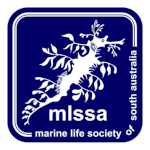
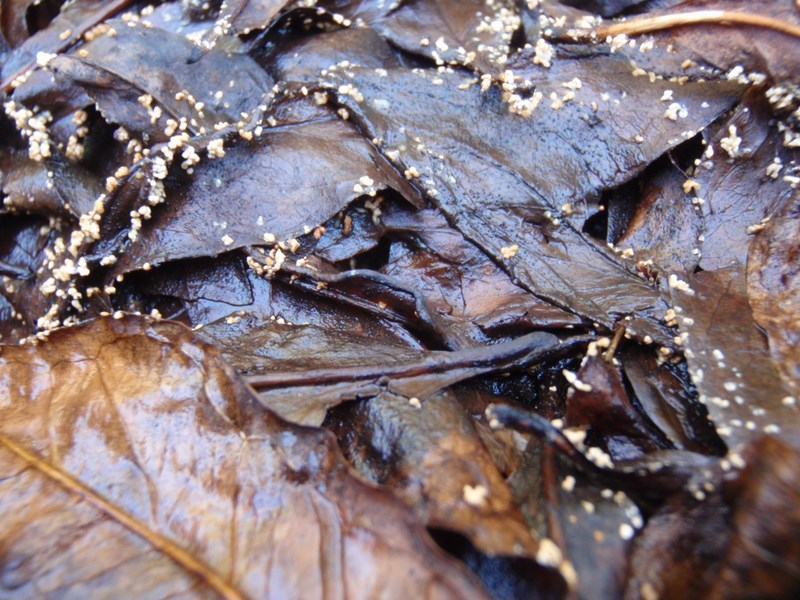
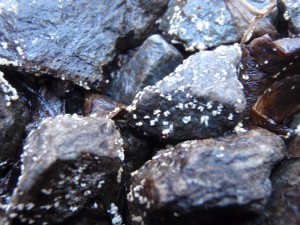
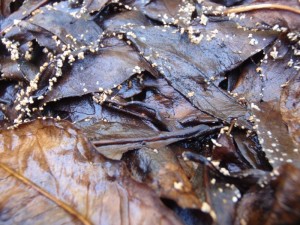
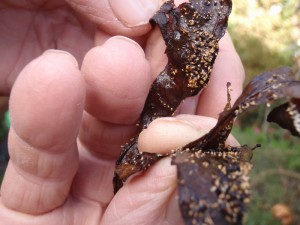
If its of any interest I have Slime mould growing from my grass. Large, size of a dinner plate. First time I broke it down it was a powder external crust with a soft decay of slime under it.
Trying to find out if this is common?
Regards,
Paul
Hi Paul, thanks for these details. WE will check it out through our “slime mould’ expert.
Cheers, Steve
I too knew nothing about slime moulds till recently when I noticed a submission on the inaturalist.org Australian website for Dog Vomit Slime Mould!
Since then I have begun to notice what look like animal Vomit on decaying tree branches and trunks of living trees in various parts of South Australia including Normanville Dunes and Warraweena Station northern Flinders Ranges. I’ve posted images on iNat and I think at least one has been validated to become Research Grade but I have not checked before writing this comment. If readers want more information on slime moulds inaturalist.org is a good starting point.